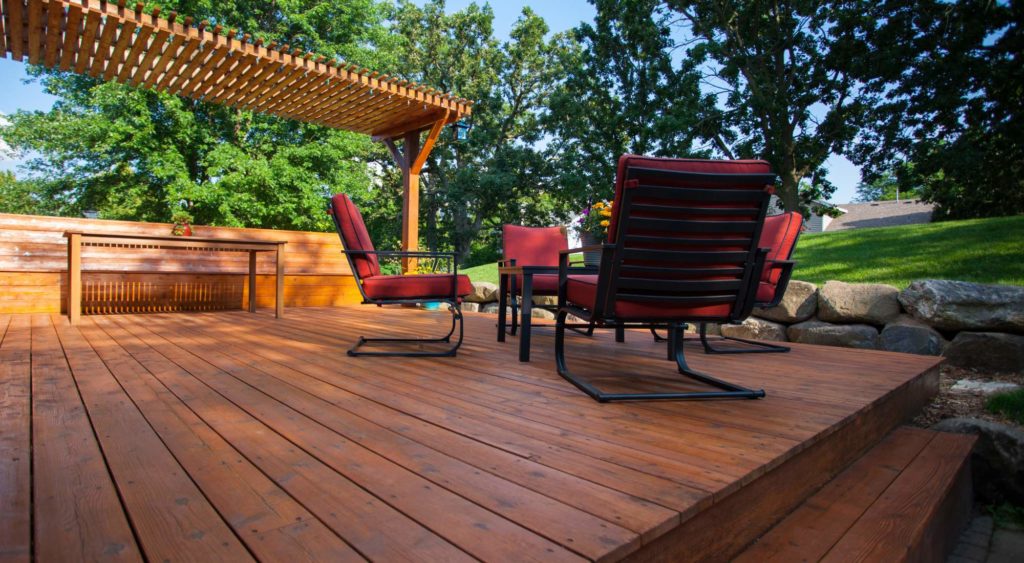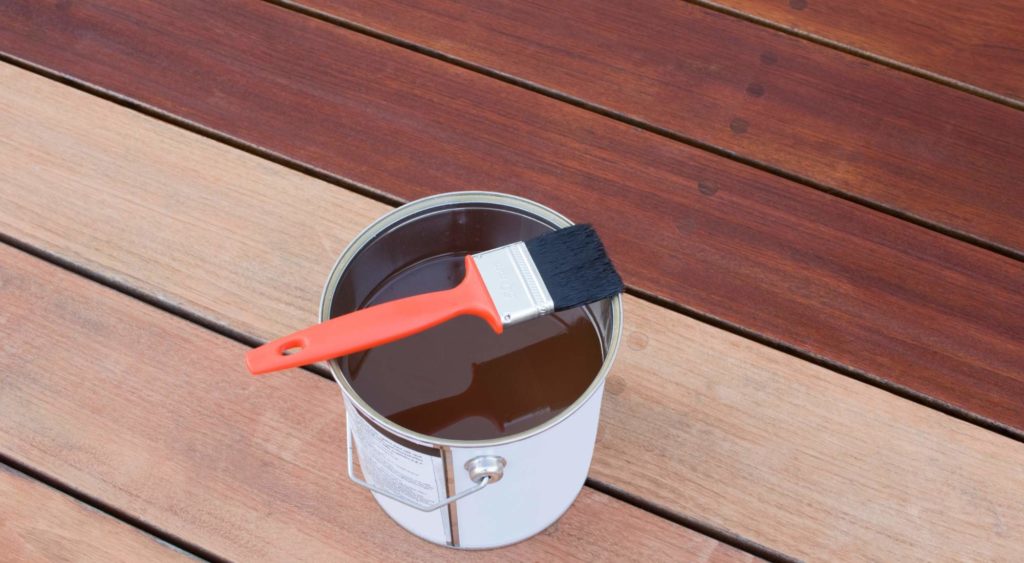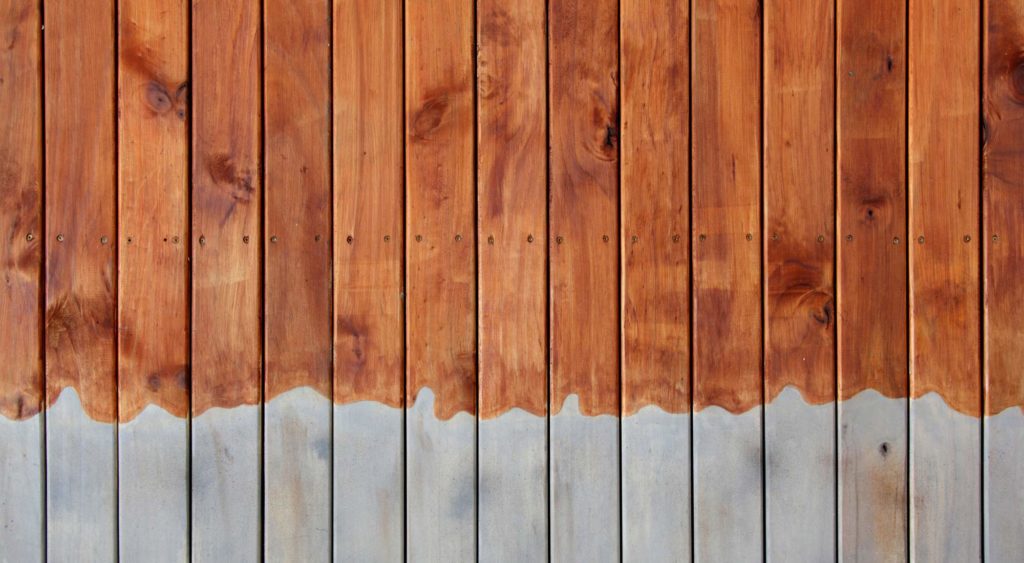Outdoor spaces are so inviting for entertaining family and friends, and your beautiful new or existing deck is the perfect gathering location for relaxing and entertaining. However, homeowners with wooden decks need to understand that in order to keep these areas looking appealing, there are necessary maintenance and upkeep steps involved.
Whether you need to restain your existing deck or stain a brand new deck, check out our tips to make sure you choose the best-performing and longest-lasting stain for decks.
Table of Contents
- What Is the Purpose of Stain on a Deck?
- 4 Things To Look for in a Long-Lasting Deck Stain
- Types of Deck Stain To Choose From
- Which Type of Deck Stain Lasts the Longest?
- 7 Things To Consider When Choosing the Longest Lasting Stain for Your Deck
- Rely on the Pros at Two Brothers Painting To Choose and Apply the Longest-Lasting Stain for Your Deck
What Is the Purpose of Stain on a Deck?
To choose the best and longest-lasting stain, it is important to understand the purpose of stain — and it’s more than just to make a deck look good.
Key purposes for stain:
- Repel water – When wood absorbs moisture, it swells, and then when it dries, it shrinks. If this happens repeatedly, the deck structure can become compromised. The wood will warp, crack, and become uneven over time.
- Block harmful ultraviolet rays – These UV rays will lead the wood to deteriorate faster. If your deck is exposed to the sun on a routine basis without a protective coating, UV rays will break down the wood structure at a faster rate than if protected. UV rays will also lead to fading and a dull appearance, which can then make your deck appear more as an eye sore than a benefit to your home.
- Resist mold and mildew – Mold tends to grow in damp or dark places, and if your deck has repeated exposure to moisture without a protective stain or paint, the moisture that remains in the wood can become a breeding ground for mold. Mold and mildew can not only compromise your deck structure over time, but they can also become a health concern.
- Prolong the overall life of your deck – Investing time and some money into your new or existing deck by staining, sealing, or painting can prolong the life of the structure and add additional and enjoyable outdoor space to your home.
4 Things To Look for in a Long-Lasting Deck
The cost of your outdoor deck is quickly outweighed by the value it adds to your home, making it a worthy home improvement project. But now, you wonder, how do I best protect my investment with the best and longest-lasting stain?
There are four particular characteristics and components in deck stains to consider:
- Natural oils
- Colorants
- Damage resistance benefits
- Low volatile organic compounds (VOCs)
#1: Natural Oils
Natural oils penetrate directly into the wood and do not require a sealer.
The oils tend to last longer and be more durable than water-based stains that are unsealed, as they do not sit on top of the wood, but rather soak directly into it.
#2: Colorants
Colorants in wood stains consist of either transparent iron oxide or dye.
The transparent iron oxides tend to be more durable, last longer, and do not fade as quickly as dyes.
Typical dyes used in stains are water-soluble, which means they can be rinsed off the wood if exposed to moisture and they do not usually last as long as the transparent iron oxides.
#3: Additional Damage Resistance
Some products — but not all — contain additional damage resistance protection, such as blocking ultraviolet (UV) rays from the sun and resisting mold and mildew.
If you live in a particularly humid or rainy climate, choose a stain with the extra mold and mildew resistance products included.
If your deck will be in direct sunlight for much of the day, it would be wise to choose a product with UV blocking in it to avoid over-drying and fading.
Be sure to do your research and choose the product most suitable to your climate and needs to ensure the best and longest-lasting stain protection for your deck investment.
#4: Low VOCs
Volatile Organic Compounds, or VOCs, are the products responsible for scents and odors along with pollutants. Some VOCs are not only harmful to humans and animals, but the environment and can contribute to poor air quality and smog concerns.
Even if the deck is outdoors and not in a confined space in which odor would be more noticeable, it is important to choose a product with low VOCs.
Types of Deck Stains To Choose From
Your initial research revealed many options for staining your deck, but how do you know which deck stain is the right one for your project? The right choice of stain depends on the type of wood used in the construction of your deck, your climate needs, sun exposure, and maintenance goals, but there are numerous varieties from which to choose.
Types of stains to consider:
- Water-based
-
-
- Pros: Environmentally friendly, decreased chance of mold or mildew growth, water clean-up
- Cons: Applications dry quickly, do not penetrate the wood like oil-based stains, prone to peeling with wear
-
- Oil-based
-
-
- Pros: Easy to apply, natural appearance, good penetration into wood
- Cons: Longer drying and curing time, stronger odors, may darken over time, some prone to development of mildew
-
- Deck resurface coatings
-
-
- Pros: UV protection, fills cracks in wood, increased traction, great for older deck repairs
- Cons: Short life, involves sanding and scraping
-
- Solid color stains
-
-
- Pros: Great UV protection
- Cons: Does not penetrate wood well, prone to peeling, sits on top of wood and looks like paint
-
- Semi-solid color stains
-
-
- Pros: Excellent UV protection, water-based products prone to peeling
- Cons: Natural wood grain will be covered, oil-based products penetrate wood and perform better than water-based products
-
- Transparent stains
-
-
- Pros: Natural appearance, easy to apply and reapply as needed
- Cons: Below-average UV protection, typical annual application
-
- Semi-transparent stains
-
-
- Pros: Average UV protection, allow natural wood grain to be visible, good penetration into wood
- Cons: Water-based products perform poorly, low availability of oil-based products with low VOCs
-
- Clear sealers
-
- Pros: Easy application, does not change the appearance of the wood
- Cons: Graying of the wood in a short time from UV rays
Which Type of Deck Stain Lasts the Longest?
Many people contend that stains made from natural oils last the longest, but this may not line up with the outdoor conditions of your home or your vision for your deck.
Deck stains preserve and protect exterior wood, but there may not be just one that is best for your project — choosing the longest-lasting stain for your deck depends on a variety of factors and variables.
7 Things To Consider When Choosing the Longest Lasting Stain for Your Deck
#1: Aesthetics
Ultimately, the main goals for choosing a stain are to preserve and protect your deck and to fit your style and appearance preferences.
Some homeowners may prefer natural wood stain colors like cedar, which tend to be lighter and work well with rustic or minimalistic designs. Another upside of a light-colored stain is that it doesn’t show footprints as much as a darker color, which helps keep your deck looking fresh and clean.
Wood finishes and stain colors such as dark charcoal, blues, or greens can create a more bold and contemporary style. A benefit of darker stains is they will show less dirt, however, wear patterns may be more evident in the areas of frequently-traveled pathways.
Finally, consider curb appeal or color pop — you may want the stain finish to contrast the color of your house, rather than blending in as a similar color.
#2: Cost
One consideration to include is the future costs of maintaining your choice of stain or finish for years to come. Is your choice one that will need updating within the next year or two, or will it last numerous years before requiring updating?
A quality stain may cost more upfront, but you will save money in the long run. We always tell our clients to avoid cutting corners on materials.
#3: Type of Stain Base
You can choose from oil-based or water-based stains.
Oil-based stains tend to have a more natural appearance, allowing for the wood grain to remain visible, and the color is muted. These stains soak into the wood structure and do not allow water to penetrate. Oil-based stains tend to cure slowly as the oil hardens.
Water-based stains have a more solid appearance — similar to paint — with a wider availability of color choices. Water-based stains cure quickly as moisture evaporates and the pigments remain. They are easy to apply with a smooth appearance, however, more frequent applications are necessary for maintenance than oil-based products.
#4: Wood Type
In addition to choosing an oil-based or water-based stain, you also need to consider what type of wood will stand the test of time and elements the best. Different types of wood will accept certain stains better than others, and some wood types require more frequent maintenance depending on the climate.
#5: Penetration
Protection of the wood is achieved when the stain actually soaks into or penetrates wood grain. Stain that remains just on the top of the wood does not provide much protection, and you will find it necessary to apply more frequently. There is also more potential for wood damage.
For example, with oil-based stains there is no waiting time between coats — it’s important to apply “wet-on-wet”. The first coat penetrates the wood, and the second coat is applied while the first coat is still wet, utilizing the initial coat as a vehicle to penetrate further into the wood grain.
Semi-transparent or clear stains provide better coverage and penetrate the wood. Clear stain is universal and can be utilized on all woods, but does not provide the best UV protection — this is where pigment can be of assistance as it enhances or provides color while adding UV protection.
#6: Samples and Availability
Your new deck is a “blank canvas” or your existing deck needs a refresh, but you’re just not sure what you want.
Get samples.
Before spending money on a product that you’re not sure about, obtain a sampling of products before starting the job. Not only will this save money if you don’t end up liking a certain look, but you also need to be sure you can obtain similar products for maintenance concerns in the future.
This can also be beneficial if you are deciding between oil-based products versus water-based products for appearance and performance on your wooden deck.
#7: Prep Work and Application
Be sure not to skip any steps with preparation, as it will be detrimental for the stain to adhere to your deck properly and ultimately lead to more cost and work in the future.
Preparation and application of stain depends on whether the stain is oil-based or water-based, and the type of wood on which it is being applied, along with how many coats need to be applied.
How many coats are typically applied? It depends on the type of wood and coverage desired.
Two coats are common, with the first coat applied heavily to soak into the wood, then a second coat for any spots where it appears lighter or uneven. The pros at Two Brothers Painting often will apply two or more coats to achieve the best coverage.
The main object is to apply, cover, and seal to protect the wood, but not over-apply resulting in thickened areas.
The easiest way to be sure your stain will be applied correctly and efficiently, without you needing to invest the time or labor is to let the pros at your do the work for you. Let your Portland painting company contractor give you the best help and advice for optimal appearance and the longest-lasting stain for your deck.
Rely on the Pros at Two Brothers Painting To Choose and Apply the Longest Lasting Stain for Your Deck
You can rely on the professionals at Two Brothers Painting for your new or existing deck projects. With more than 150 years combined years of experience, we provide our clients with professional recommendations and information for upcoming finishing or restoration needs.
From the initial estimate to choosing colors and the longest-lasting stain products for your new or existing deck, our team is here to meet your needs and goals. Contact us today for a prompt response to get your project started!




